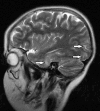Posterior reversible encephalopathy syndrome in a child with cyclical vomiting and hypertension: a case report
- PMID: 21470405
- PMCID: PMC3080322
- DOI: 10.1186/1752-1947-5-137
Posterior reversible encephalopathy syndrome in a child with cyclical vomiting and hypertension: a case report
Abstract
Introduction: Posterior reversible encephalopathy syndrome is characterized by headache, nausea and vomiting, seizures and visual disturbances. It has certain characteristic radiological features, which allow diagnosis in the appropriate clinical setting and enable appropriate clinical therapy to be instituted.
Case presentation: A 10-year-old Caucasian girl who was hospitalized due to recurrent vomiting was diagnosed as having posterior reversible encephalopathy syndrome after an initial diagnosis of cyclical vomiting and hypertension was made.
Conclusion: Posterior reversible encephalopathy syndrome is a rare disorder in children. Early recognition of characteristic radiological features is key to the diagnosis as clinical symptoms may be non-specific or mimic other neurological illnesses. To the best of our knowledge this is the first case to report an association between posterior reversible encephalopathy syndrome, cyclical vomiting and hypertension. Furthermore, in this case, the resolution of the abnormalities found on magnetic resonance imaging over time did not appear to equate with clinical recovery.
Figures


Similar articles
-
Posterior Reversible Encephalopathy Syndrome: Three Ethiopian Hypertensive Patients Presented with Recurrent Seizure: Case Series and Literature Review.Ethiop J Health Sci. 2019 Jul;29(4):525-528. doi: 10.4314/ejhs.v29i4.14. Ethiop J Health Sci. 2019. PMID: 31447526 Free PMC article. Review.
-
Posterior reversible encephalopathy syndrome in acute intermittent porphyria.Pediatr Neurol. 2014 Sep;51(3):457-60. doi: 10.1016/j.pediatrneurol.2014.05.016. Epub 2014 May 21. Pediatr Neurol. 2014. PMID: 25035140
-
Posterior reversible encephalopathy syndrome as a complication of Henoch-Schönlein purpura in a seven-year-old girl.Scott Med J. 2017 Feb;62(1):34-37. doi: 10.1177/0036933017690467. Epub 2017 Feb 2. Scott Med J. 2017. PMID: 28152662
-
Clinical and MRI Features of Posterior Reversible Encephalopathy Syndrome With Atypical Regions: A Descriptive Study With a Large Sample Size.Front Neurol. 2020 Mar 24;11:194. doi: 10.3389/fneur.2020.00194. eCollection 2020. Front Neurol. 2020. PMID: 32265829 Free PMC article.
-
[PRES (Posterior Reversible Encephalopathy Syndrome): potential complication of hypertensive crisis. Case report and literature review].G Ital Nefrol. 2017 Apr;34(2):100-109. G Ital Nefrol. 2017. PMID: 28682567 Review. Italian.
Cited by
-
Posterior reversible encephalopathy syndrome in a survivor of valproate-induced acute liver failure: a case report.J Med Case Rep. 2013 May 31;7:144. doi: 10.1186/1752-1947-7-144. J Med Case Rep. 2013. PMID: 23724918 Free PMC article.
-
Posterior reversible encephalopathy syndrome: characteristics, diagnostic accuracy, prognostic factors and long-term outcome in a paediatric population.Acta Neurol Belg. 2022 Apr;122(2):485-495. doi: 10.1007/s13760-021-01819-7. Epub 2021 Oct 24. Acta Neurol Belg. 2022. PMID: 34693510
-
Posterior reversible encephalopathy syndrome unmasking acute glomerulonephritis.J Clin Diagn Res. 2014 Jan;8(1):177-8. doi: 10.7860/JCDR/2014/6465.3818. Epub 2014 Jan 12. J Clin Diagn Res. 2014. PMID: 24596763 Free PMC article.
References
LinkOut - more resources
Full Text Sources

